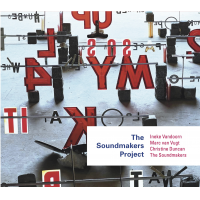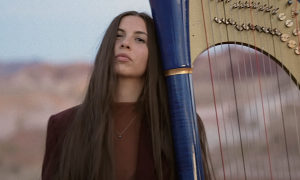Home » Jazz Articles » Interview » David Sanchez: A Candid Look at Music and Business, Part 1 of 2
David Sanchez: A Candid Look at Music and Business, Part 1 of 2
I did this record because I actually admire and appreciate that other feel - more subtle; something that's not being able to come up with 300,000 notes.
—David Sanchez on his release Coral
 It's hard to gauge what the jazz community knows about saxophonist David Sanchez. If you have BET Jazz, you may have seen him on those corny interludes - "How did you discover your sense of jazz?" Albeit, a lot of people I've talked to, know very little about Sanchez. "Go look at the records - then you'll see I've been around for quite a while," says Sanchez in the lobby of the Sheraton Hotel in the Steel City.
It's hard to gauge what the jazz community knows about saxophonist David Sanchez. If you have BET Jazz, you may have seen him on those corny interludes - "How did you discover your sense of jazz?" Albeit, a lot of people I've talked to, know very little about Sanchez. "Go look at the records - then you'll see I've been around for quite a while," says Sanchez in the lobby of the Sheraton Hotel in the Steel City.
Most people don't realize it, but Sanchez has been on the New York scene since 1988 when he came to complete his studies at Rutgers. I defer to R.J. DeLuke's previous interview to fill you in on the particulars up to the time preceding Sanchez' 2000 release Travesia.
Since then, the tenorist has continued touring fairly regularly. He has been doing university performances and clinics frequently as those venues today are consistently interested in hosting major recording artists - whom many of their jazz students are listening to. Just in the past few weeks since we spoke, Sanchez performed at the University of Indiana in Bloomington, IN and at University of California, Berkeley following a three-night stint at Yoshi's.
His quintet has stayed the same since Travesia - with bassist Hans Glawischnig, pianist Edsel Gomez, drummer Antonio Sanchez, and percussionist Pernell Saturnino. Since introducing the jazz world to altoist and fellow Puerto Rican Miguel Zenon, the two saxophonists have continued to work together including on Sanchez' most recent and musically diverse album to date, Coral.
I caught up with Davíd in Pittsburgh, where he was speaking at a conference called the Performing Arts Exchange. He had flown in that morning from New York where he'd been at the Blue Note the previous two nights celebrating the centennial of Coleman Hawkins birth along with an all-star line-up including Frank Wess, Jimmy Heath, David 'Fathead' Newman, and James Carter; and a rhythm section of Eric Reed on piano, Carl Allen on drums and Ray Drummond on bass.
We discussed a wide variety of topics; from the current record to the state of the record industry to his attitude on how young people today are listening and sounding to cyberspace as a marketing medium.
All About Jazz: Is this your first time in Pittsburgh?
David Sanchez: Oh no. Not at all. I was here with Slide Hampton as part of the "Jazz Masters" band which was made up of former Dizzy Gillespie alumni.
AAJ: Yeah. I think they're calling that the Dizzy Gillespie Alumni band now.
DS: I think you're right. I was here with Ray Drummond, with Charlie Haden, with my own band. So no, I've been here many times. I don't remember the years but yeah, I've been to Pittsburgh in many different situations. (I didn't realize until after I sat down to write this interview that I had planned to attend the Haden concert, which occurred at Manchester Craftsmen's Guild in February of 2003, but was not able to make it due to school obligations. I recall several of my friends going and noting that Haden soloed very little and that Sanchez's improvisations were the highlight of the performance. Many of them had never heard of Sanchez prior to the concert.).
AAJ: What's going on this weekend?
DS: Well, this is a whole different thing. This is like... a convention. Honestly, I'm not exactly sure what's goin' on, but I know that a part of it, is that we're playing. I think it's a whole bunch of different bands and we'll all be playing for different agents.
AAJ: So it's like for performing arts presenters?
DS: Yeah. Basically, that's what it is. It's not like before when we played the Cultural Center, the...Marty Ashby?
AAJ: Manchester Craftsmen's Guild.
DS: Exactly. Manchester. That was with the group. Obviously you were not there. Otherwise you would remember. That was the sextet. I brought my whole group.
AAJ:How did you meet Miguel Zenon. I know you're both from Puerto Rico. Did you grow up together? I get the impression that he's a bit younger than you.
DS: Yeah he's definitely younger than me. I first met Miguel when he was starting at Berklee in the mid 90s. He came to see my group when we were playing there. That's how I met him. We didn't grow up together. There's a difference of maybe seven or eight years between us.
AAJ: My bad.
DS: Yeah a lot of people don't know. But if they go back to the records, they'll realize that I was doing this thing since way back so... you know...but he just happened to be interested in some of the stuff that I was working on already. So we happened to be from the same place and actually he knew all my stuff. That's why I was so impressed, cause he knew all my stuff when I came to Boston.
AAJ: He knew all your charts?
DS: Yeah. By heart.
AAJ: Wow.
 DS: So when he came to New York, I had this idea. There were not many groups lately at that time, in 2000, that had the front line of just tenor and alto. Basically the configuration of the sextet with percussion and two horns [in relation to] this concept that I had been working on - of making a real combination or a hybrid of playing Latin American music and jazz - I didn't really see or hear this combination. On Meláza I was working with very cutting edge material, in the sense that it was advanced material - a lot of counterpoint and a lot of advanced harmonies. And I though another horn would give it a whole different vibe so that's when Miguel and I started working together.
DS: So when he came to New York, I had this idea. There were not many groups lately at that time, in 2000, that had the front line of just tenor and alto. Basically the configuration of the sextet with percussion and two horns [in relation to] this concept that I had been working on - of making a real combination or a hybrid of playing Latin American music and jazz - I didn't really see or hear this combination. On Meláza I was working with very cutting edge material, in the sense that it was advanced material - a lot of counterpoint and a lot of advanced harmonies. And I though another horn would give it a whole different vibe so that's when Miguel and I started working together.
AAJ: Yeah. It gives a different timbre. Alto and tenor.
DS: Exactly. It was just a new idea that I had.
AAJ: Switching topics. Going back a few years. I have this record. It's a Ryan Kisor date on Columbia called On the One. Do you remember that record?
DS: {Jaw drops} Yeah. Wow. That's a long time ago.
AAJ: Yeah. I just picked it up. It's absolutely killin'. Chris Potter on alto...
DS: Mark Turner on tenor, Christian McBride on bass...Yeah, yeah I remember {smiles).
AAJ: This is before you guys were big. What was it like to make that record? Did you know all those cats before the recording session?
 DS: I knew Mulgrew [Miller]. Actually I knew the whole rhythm section. Why? Because we had been working together on the Philip Morris Superband tour. Mulgrew I knew from another place. Lewis [Nash], Ryan and Chris - Christian McBride too was on that record. Wow. So yeah I knew those guys already. We had been on tour together for two months I think. I've been around.
DS: I knew Mulgrew [Miller]. Actually I knew the whole rhythm section. Why? Because we had been working together on the Philip Morris Superband tour. Mulgrew I knew from another place. Lewis [Nash], Ryan and Chris - Christian McBride too was on that record. Wow. So yeah I knew those guys already. We had been on tour together for two months I think. I've been around.
You know people see me in concert and they think...'Hmm this guy is a new cat. He's a young guy.' But you know I've been around for a while now. Part of it is that I have a "baby face," so people think I'm younger than I am. I'm 35. And that brings me to the question of why I'm changing paths and trying to do different things. Sometimes...you know...I have been pretty consistent in the concept I'm trying to bring. It's one thing. Whether you like it or not - it is what it is. But as I get older and time goes by, you wanna be doing different kinds of things.
I was working with a lot of originals on Melaza and Travesía. But then as time goes by I want to be working on different things. Like the Coral project - it's really about focusing on simplicity - aside from my originals - but specifically with the other songs I found that it was very simple -simple material and it was short pieces. I wanted to just change them around a little bit and be able to create something new while focusing on playing with beauty and simplicity.
AAJ: Those melodies are so lush with the strings.
DS: Yeah...and perhaps working with Charlie Haden gave me that other side. And it's really beautiful. In jazz I hear a lot. Part of that is this other side in the music. I didn't do this record because 'Oh look at me. I can do all this stuff.' No. I did this record because I actually admire and appreciate that other feel - more subtle; something that's not being able to come up with 300,000 notes.
AAJ: Which a lot of people out there know you for.
I want to switch topics now. You came here from the Blue Note as I understand it. What was going on there?
DS: This was a special project. It was paying tribute to the great Coleman Hawkins. As you know this year is the centenary.
AAJ: Right. In your last interview on AAJ, three years ago with R.J. DeLuke (see David Sanchez and His Universe , November 2001), you were talking about how you were only recently getting into the older guys. You said early on you had influences on the saxophone including Coltrane and Sonny Rollins and Dexter Gordon, but you really hadn't gotten to those older cats. And a lot of people haven't heard this music. It all happened and the records are there, it's just people want to only listen to other stuff or what's in the present.
DS: Yeah. When you go back to that period in time, there's a lot of information there. It's pretty unbelievable what these guys were doing in the late 20s, and the 30s and 40s - all before bebop. And also, I must say the preparation they had was very high. I mean some of these guys - like Coleman Hawkins - this guy played cello, he was very knowledgeable in harmony, he knew the structures. He went to a conservatory in Europe. When he came back to the States, he was looking at music in a whole different way. It's very advanced. And it's extremely important if you're a saxophonist. I mean if you're one of the younger guys today, it happened to me too, you start out checking Coltrane and then you start checking out [more recent] guys - guys who maybe, perhaps you shouldn't start checking. That's the way it goes. It was all there all the time and I didn't realize it.
You mentioned sound, harmonic direction - he was actually another guy that was changing all the time also. He was never happy with just speaking to one thing all the time. He was trying this and that. It was a great experience to do this show at the Blue Note. I couldn't do the weekend because I had this and then from here I'm going to L.A. I had to cut it short. So I did the first half of the week, but that's great because it was the masters - the older guys like Frank Wess, Jimmy Heath, David "Fathead" Newman, and then also newer guys like me and James Carter (also trumpet player Terrell Stafford).
AAJ: Did James Carter do his crazy thing?
DS: Yeah, no. Well you know, James is gonna do his thing, man. Actually, this particular project - it's his thing. He is very influenced by this particular period of time - this music. Not only Coleman Hawkins, but a lot of Chu Berry, and Lester Young. And then through those guys, there are the guys that he's really been influenced by, like Eddie "Lockjaw" Davis etcetera. But you know it was a great experience exactly because of that. There was so many cats there and every guy has his own unique voice. We were talking about this in the dressing room last night. It's amazing that all these players with the same instrument, have completely different voices.
And that's another thing I have to say to the younger generation. Perhaps when you don't check as much of the spectrum, and the different ways of playing music, all of a sudden your concept is compressed and everything kind of sounds similar. I'm talking about sounds now. I'm talking stylistically. You can see it. You can hear it. Today, it's almost like a factory - almost generic. Not because it's bad, but it's compressed. Maybe it's because they're just checking out one or two things.
AAJ: And they may be checking out you. Or they might be checking out just Chris Potter or Mark Turner.
DS: Exactly. Great, great! Beautiful, great - check everything. But don't forget. Really check everything. This is very important. You must do that in order to have different perspectives. Like Sonny Rollins for instance. Oh my idol, Senator Sonny Rollins. How close is this to Coleman Hawkins? You really see a lot of the sound, a lot of the attitude comes from Coleman Hawkins. Sometimes from one player, there is a bridge to another earlier guy. It's a way for you to get to all the players. A young guy listens to Sonny Rollins. Sonny Rollins is my idol but his sound and attitude come from Coleman Hawkins. Dexter Gordon. From the first time I heard Dexter on record in Puerto Rico, I did not know anything about jazz but I immediately connected with that sound. And that helped lead me to Lester Young that I was not that familiar with. Or the same for Stan Getz also. Check it out. That's Prez. Comes from the line of Prez.
On to Part 2 ...
Visit David Sanchez on the web at www.davidsanchezmusic.com .
Tags
PREVIOUS / NEXT
Support All About Jazz
 All About Jazz has been a pillar of jazz since 1995, championing it as an art form and, more importantly, supporting the musicians who make it. Our enduring commitment has made "AAJ" one of the most culturally important websites of its kind, read by hundreds of thousands of fans, musicians and industry figures every month.
All About Jazz has been a pillar of jazz since 1995, championing it as an art form and, more importantly, supporting the musicians who make it. Our enduring commitment has made "AAJ" one of the most culturally important websites of its kind, read by hundreds of thousands of fans, musicians and industry figures every month.


























